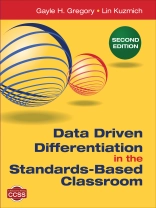Collect the data you need to reach every student!
When it comes to meeting the rigorous new standards of the Common Core Curriculum, knowing how to collect, analyze, and use data makes all the difference. Fully updated to support the Common Core and other key standards, this informative book shares an author with the best-selling Differentiated Instructional Strategies: One Size Doesn’t Fit All.
Veteran educators Gregory and Kuzmich provide user-friendly techniques for gathering qualitative and quantitative information, helping you tailor instruction and assessment for diverse learners. This resource is ideal for classroom teachers, curriculum developers, instructional leaders, and district administrators. Readers will find:
- Step-by-step guidance on gathering data to improve classroom dynamics, pinpoint student learning styles, adjust lessons for different learners, and inform diagnostic teaching and assessment
- Techniques for using data to enhance curriculum, including numerous unit and lesson plans fully linked to the Common Core
- A wealth of templates for fast and simple data collection
- Updated differentiation strategies for the Common Core and other key standards, including the Career and College Readiness Standards and the Standards of Mathematical Practice
Collect data with ease and discover new tools for differentiated teaching and learning!
Praise for the First Edition:‘This book reconciles meeting children’s affective needs with the new accountability requirements from the federal and state government. The title may sound daunting, but the chapters are extremely accessible.’
—Maria Elena Reyes, Associate Professor
University of Alaska Fairbanks
表中的内容
Preface
Acknowledgments
About the Authors
Introduction: Differentiating With Data for Student Growth and Achievement
What Is Our Target?
Challenges and Shifts Presented by the Common Core State Standards
Why Differentiate?
Theaters of the Mind: Learning Systems and the Brain
Learning Systems and Student Growth
Connecting Data to Learning
Using Classroom Data to Plan Differentiated Instructional Strategies
Targeting Growth for All Students
1. Collecting Data to Create a Positive Classroom Climate
Positive Classroom Connections
Assessing the Learning Environment
Using Feedback
Ritual, Respect, and Cultural History
Differentiating Classroom Climate
Differentiating Celebration and Praise
Summary
2. Collecting Data to Know the Learner
Going With the Flow
Learning Profiles
Different Learning Preferences
Different Intelligences
Student Contracting for Reflective Learning
Gender Differences
Cultural Differences
Pop Culture Differences
21st Century Learners and Technology
Reflections
3. Collecting and Using Assessment Data for Diagnostic Teaching
Diagnostic Teaching
Pre-Assessment
Formative Assessment
Final Assessment
Assessing Our Assessments
Summary
4. Curriculum Approaches for Data Driven Instruction
Curriculum Mapping and Data Driven Instruction
Standards-Based Unit Planning: Sample Math Unit on Data Analysis and Probability, ‘The Survey Says . . . , ‘ Grades 3 to 5
Critical Questions for Unit Planning
Pre-Assessing the Learning Gap for Unit Planning
Chunking the Learning
Summary
Other Sample Unit Plans
The Weather Reporter, Grades K to 2
Do You Know Your Rights? Grades 5 to 8
Argumentation Writing–Convince Me! Grades 9 to 12
5. Adjustable Assignments for Differentiated Learning
Options for Differentiated Learning
Adjustable Learning Grids
Adjustable Learning Elements
Flexible Grouping
Differentiating Pairs
Differentiating Small Groups
Summary
6. Instructional Strategies That Increase Student Learning
The Art and Science of Teaching
Memory Processes and the Cognitive Learning System
Differentiating Instructional Strategies
Cooperative Group Learning
Nonlinguistic Representations
Summarizing and Note Taking
Homework and Practice
Recognizing Similarities and Differences/Using Metaphors and Analogies
Summary
7. Data Driven Lesson Planning for Differentiated Learning
Using Data for Lesson Planning
Essential Elements for Data Driven Lesson Planning
Chunking the Learning for Sample Unit Plans
Summary
Conclusion: Putting It All Together for Student Growth and Achievement
How Do We Do All This Without Running From the Room Screaming?
What Can We Learn From the Errors and Successes of the Best Teachers?
What Are the Major Changes With Common Core State Standards?
Why Is It Always About the Student?
References
Index
关于作者
Lin Kuzmich, of KCS, Inc., is an educational consultant, professor, and author from Loveland, CO. She served the Thompson School District in several roles as the assistant superintendent, executive director of secondary and elementary instruction, director of professional development, and a building principal. Her school was named a 2000 winner of the John R. Irwin Award for Academic Excellence and Improvement. In addition, for the past decade she has been involved in staff development through several universities and the Tointon Institute for Educational Change. Kuzmich is an adjunct professor at both Colorado State University and University of Northern Colorado. She is a senior consultant for the International Center for Leadership in Education, has provided training and consulting to school districts around the country, and has presented at numerous national conferences.












